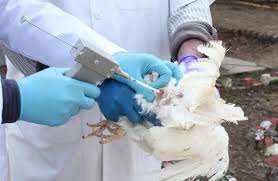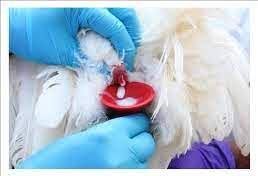ARTIFICIAL INSEMINATION A RELIABLE TOOL FOR POULTRY BREEDING
Dr. Surya Kant*1, Dr. K. D. Singh2, Dr. A. K. Verma2, Dr. M. K. Verma3 and Dr. P. S. Pramanik1
*1PG Scholar, Department of Livestock Production Management
1Professor & Head, Department of Livestock Production Management
2Assistant Professor, Department of Livestock Farm Complex
3Assistant Professor, Department of Animal Genetics and Breeding
College of Veterinary Science & Animal Husbandry, ANDUAT, Kumarganj, Ayodhya, U.P.
The most often utilized and worldwide accepted reproductive technique in the livestock sector is artificial insemination (AI). Particularly in western nations where it is used for commercial and research purposes, it has grown more and more popular among poultry species. A prominent method for increasing the reproductive success of birds is artificial insemination, especially in broiler breeders and turkeys with low fertility because of their huge body weight. The process begins with the collection of male semen, which is then examined for motility, viability, and concentration before being deposited into the female reproductive tract. To be productive in creating fertilized eggs, one must be technically proficient with the semen collection and deposition methods. Males can start producing semen at the age of 12 weeks depending on the plane of nutrition, lighting program and size of body.
However, such roosters rarely produce viable, useful sperm as maturity doesn’t set in until the bird is at least 18 weeks old. Thus, semen is collected from cocks that are 22 or 24 weeks old. Spermatozoa and seminal plasma make up the semen. Broiler fowl semen typically contains 3 to 8 billion spermatozoa per milliliter. Semen from chickens is typically white or pearly white in color. Males of heavy breeds can generate 0.75 to 1 ml of semen, whereas males of light breeds can produce 0.4 to 0.6 ml. When held for more than an hour, chicken semen starts to lose its potential to fertilize. The vitality of the spermatozoa can be preserved for six to twelve hours by transporting chicken sperm in liquid cold (4°C) storage. From a healthy cock, four to six times per week, semen can be collected. Although daily semen collection won’t affect the ability to fertilize but volume of semen will be small in quantity. When viable eggs are needed, inseminations should be performed twice in a row during the first week and then once per week after that. Insemination of chickens should be finished within an hour of semen collection since poultry semen has a very short shelf life. The optimal time to perform the operation is between 2 and 4 pm, though it is a good idea to do it every day. The main cause of this is that most chickens have an egg in the oviduct in the morning, which prevents semen from freely moving to the ovary. The fact that it is typically colder and the hens are less likely to be impacted by heat, especially in late spring, is another argument in favor of inseminating the hens in the afternoon.
A.I. equipment requirements:
- Small glass funnel with wax filled stem.
- Inseminating syringe.
- Wide mouthed glass vial.
- Small Pyrex semen cup.
- Large flask with the capacity to contain water at 180 to 200 degree Celsius for temporary storage of semen to a short time.
Semen extraction
The manual collection (milking) of semen is the initial stage in an AI program. Semen collection often involves a two-person team, with one person restraining the male and the other collecting the sperm. The bird is held by someone holding it horizontally at a height that is convenient for the person trying to collect the semen. The operator should use the thumb and index finger of the left hand to gently massage the cloaca on both sides in order to accumulate sperm. The operator should hold a collecting funnel in his right hand and use his thumb and index finger to massage the soft area of the abdomen beneath the pelvic bones. Till the papilla emerges from the cloaca, rapidly and persistently massage the cock. Using the thumb and index finger of the left hand, which were previously positioned, the semen is pressed into the collecting funnel once the papilla is fully protruded. Feathers or feces shouldn’t enter into the sperm. When held for more than one hour, chicken semen starts to lose its potential to fertilize. The spermatozoal viability of semen can be preserved for six to twelve hours by transporting it in liquid cold (4°C) storage. Even while chicken semen can be frozen, its limited fertility makes it only useful for specific breeding initiatives.
Image credit: http://agrinnovateindia.co.in/
Analysis of the sperm at the time of collection
- Semen typically has a pearly white or cream tint. Avoid sperm that is yellow or impacted with feces, urine, blood, or other substances.
- Sperm shouldn’t be allowed to come in contact with water.
- Before adding more diluent to semen that has accumulated debris or impurities, carefully aspirate the contaminants.
- Put the diluted sperm in a cooler or refrigerator (3 to 12 degrees Celsius) to cool it down.
Insemination
The manual introduction of semen into the female’s vagina is known as artificial insemination (AI). Semen extraction from the male and insemination into the female are the two main steps of the process. When laying cages were introduced in Australia in the late 1950s, artificial insemination became widely utilized there. It was initially employed in America in the 1920s. Before use, all insemination-related equipment needs to be thoroughly cleaned and dried. The bulk of the birds must have finished laying before insemination can be done because a hard-shelled egg at the lower end of the oviduct prevents insemination and reduces fertility. In actuality, fertilizing chicken after three o’clock in the afternoon had superior outcomes. Insemination of hens that do not lay eggs is challenging. The flock is typically inseminated when egg production reaches 25%. In the first week, hens are inseminated twice, then once per week after that. Insemination of hens using 400–500 million frozen–thawed chicken spermatozoa at 3 day intervals resulted in fertility levels of 90% under experimental circumstances. Each insemination in chickens will result in between 100 and 200 million sperm cells from diluted semen. For hens, 0.05 ml of undiluted pooled semen is needed at intervals of 7 days because to the lower spermatozoa concentration and shorter period of fertility. The initial insemination should occur when the hen is crouching, which suggests receptivity. Later in the season, fertility tends to decline; consequently, as chickens get older, it might be appropriate to inseminate more frequently or use more cells each dosage.
Procedure
The hen is supported by its legs while being inseminated, with the left hand placed down and the tail pulled back against the operator’s breast. In order to press the abdominal muscles, particularly those on the left side, the right hand’s thumb is put against the upper lip of the vent. Apply pressure evenly using the palm of the hand rather than squeezing with the fingers. The second operator then inserts the syringe or plastic straw about one inch (2.5 cm) into the oviduct, causing the cloaca to evert and the oviduct to protrude. The required amount of semen is then deposited at the junction of the vagina and uterus. Pressure around the vent is relieved as the inseminator discharge semen, this helps the hen keep sperm in the oviduct or vagina.
Dose and frequency of insemination:
- Chicken : 0.05 ml once per week.
- Turkey : 0.025 ml once every two weeks.
- Ducks : 0.03ml once every five days.
- Goose : 0.05 ml every seven days.
Semen quantity and sperm concentration in numerous poultry species :
| Species | Volume (ml) |
Sperm concentration (million per ml) | Sperm concentration is required for each insemination (million) |
| Broiler type chicken | 0.7 | 3500 | 150 to 200 |
| Layer type chicken | 0.5 | 4000 | 150 to 200 |
| Tom | 0.25 | 9000 | 300 |
| Gander | 0.6 | 2500 | 250 |
| Drake | 0.3 | 4000 | 300 |

Image credit: https://www.pashudhanpraharee.com/
Advantages :
- Normally, six to ten hens can be mated to one cockerel. The likelihood of this mating ratio increasing by fourfold with artificial insemination. In this way, a male with a high genetic merit for a desired trait can benefit more females.
- Even with leg damage, valuable male birds can still be employed for artificial insemination.
- AI enables the pairing of unsuitable individuals; incompatibility develops when males are heavier than females, which may cause harm to the females during natural mating.
- Even while cross breeding is extremely effective in natural environments, there can occasionally be some form of color discrimination since some hens won’t mate with a male of a different color until they have raised their young together. AI supports successful cross breeding in such a situation.
- Older males who perform exceptionally well can be used for numerous generations, but under natural mating, their useful life is constrained.
- When managing a large number of females that must lay fertilized eggs, AI enables better utilization of the cage feeding system in hatchery operations.
- It is possible to eradicate decreased fertility that results from preferred mating.
Conclusion:
The following are some benefits of AI for broilers-
- With fewer males required, there would be higher selection pressure on the male attributes of economic value, leading to greater genetic advancement for each generation, the male & female ratio would increase from 1:10 for natural mating to 1:25 with AI.
- The following advancements in poultry AI technology may occur at some point in the future as a result of research on the biology of poultry sperm and the cellular and molecular basis of oviductal spermatozoa transport, selection, and storage.
- Insemination intervals extended to 10-14 days (versus 7 day) with fewer sperm per insemination. In vitro sperm storage for 24-36 hours at ambient temperature with minimal loss of sperm viability.
References:
- Artificial Insemination in Poultry-M.R. Bakst and J.S. Dymond
- http://www.agritech.tnau.ac.in/
- Kharayat NS, Chaudhary GR, Katiyar R. Significance of Artificial Insemination in Poultry. Research & Reviews: Journal of Veterinary Science and Technology. 2016; 5(1)
- https://www.linkedin.com/pulse/details-artificial-insemination-chicken-breeder-flock-dr-sanjay-gapat?trk=public_profile_article_view



